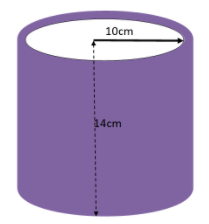
A cylindrical vessel, open at the top, has a radius 10 cm height 14 cm. Find the total surface of the vessel.
Answer
441.6k+ views
Hint: Here we will find the sum of the curved surface area of the cylindrical vessel and the area of the base of the cylindrical vessel using the formula. After calculating all these, we will get the required value of the total surface area of the vessel. A cylinder is a three-dimensional geometrical figure or structure that has two circular bases which are parallel to each other and are at some distance apart.
Formula used:
Total surface area of the cylinder open at the top \[ = 2\pi rh + \pi {r^2}\], where \[h\] is the height of the cylinder and \[r\] is the radius of the cylinder.
Complete step by step solution:
Here we need to find the value of the total surface area of the vessel which is cylindrical in shape.
It is given that the radius of the cylindrical vessel is equal to 10 cm and height of the cylindrical vessel is equal to 14 cm.
We will first draw the figure of the cylindrical vessel.

Now, we will calculate the total surface area of the cylindrical vessel which is equal to the sum of the curved surface area of the cylindrical vessel and the area of the base of the cylindrical vessel.
Total surface area of the cylindrical vessel \[ = 2\pi rh + \pi {r^2}\]
Now, we will substitute the value of the radius and the height of the cylindrical vessel.
\[ \Rightarrow \] Total surface area of the cylindrical vessel \[ = 2 \times 3.14 \times 10 \times 14 + 3.14 \times 10 \times 10\]
On multiplying the numbers, we get
\[ \Rightarrow \] Total surface area of the cylindrical vessel \[ = 879.2 + 314\]
Adding the terms, we get
\[ \Rightarrow \] Total surface area of the cylindrical vessel \[ = 1193.2{\rm{c}}{{\rm{m}}^2}\]
Hence, the total surface area of the cylindrical vessel is equal to \[1193.2{\rm{c}}{{\rm{m}}^2}\].
Note:
Here, we need to keep in mind that to calculate the total surface of the cylindrical vessel, we will find the sum of the curved surface area of the cylindrical vessel and the area of the base of the cylindrical vessel but the area of the top of the cylindrical vessel will not be included. This is because the vessel is open from the top, so only the area of base and curved surface is remaining.
Formula used:
Total surface area of the cylinder open at the top \[ = 2\pi rh + \pi {r^2}\], where \[h\] is the height of the cylinder and \[r\] is the radius of the cylinder.
Complete step by step solution:
Here we need to find the value of the total surface area of the vessel which is cylindrical in shape.
It is given that the radius of the cylindrical vessel is equal to 10 cm and height of the cylindrical vessel is equal to 14 cm.
We will first draw the figure of the cylindrical vessel.

Now, we will calculate the total surface area of the cylindrical vessel which is equal to the sum of the curved surface area of the cylindrical vessel and the area of the base of the cylindrical vessel.
Total surface area of the cylindrical vessel \[ = 2\pi rh + \pi {r^2}\]
Now, we will substitute the value of the radius and the height of the cylindrical vessel.
\[ \Rightarrow \] Total surface area of the cylindrical vessel \[ = 2 \times 3.14 \times 10 \times 14 + 3.14 \times 10 \times 10\]
On multiplying the numbers, we get
\[ \Rightarrow \] Total surface area of the cylindrical vessel \[ = 879.2 + 314\]
Adding the terms, we get
\[ \Rightarrow \] Total surface area of the cylindrical vessel \[ = 1193.2{\rm{c}}{{\rm{m}}^2}\]
Hence, the total surface area of the cylindrical vessel is equal to \[1193.2{\rm{c}}{{\rm{m}}^2}\].
Note:
Here, we need to keep in mind that to calculate the total surface of the cylindrical vessel, we will find the sum of the curved surface area of the cylindrical vessel and the area of the base of the cylindrical vessel but the area of the top of the cylindrical vessel will not be included. This is because the vessel is open from the top, so only the area of base and curved surface is remaining.
Recently Updated Pages
Questions & Answers - Ask your doubts

Master Class 11 Accountancy: Engaging Questions & Answers for Success

Master Class 11 Science: Engaging Questions & Answers for Success

Full Form of IASDMIPSIFSIRSPOLICE class 7 social science CBSE

In case of conflict between fundamental rights of citizens class 7 social science CBSE

What percentage of the area in India is covered by class 10 social science CBSE

Trending doubts
The Equation xxx + 2 is Satisfied when x is Equal to Class 10 Maths

Why is there a time difference of about 5 hours between class 10 social science CBSE

Who was Subhash Chandra Bose Why was he called Net class 10 english CBSE

Change the following sentences into negative and interrogative class 10 english CBSE

Write a letter to the principal requesting him to grant class 10 english CBSE

Explain the Treaty of Vienna of 1815 class 10 social science CBSE




